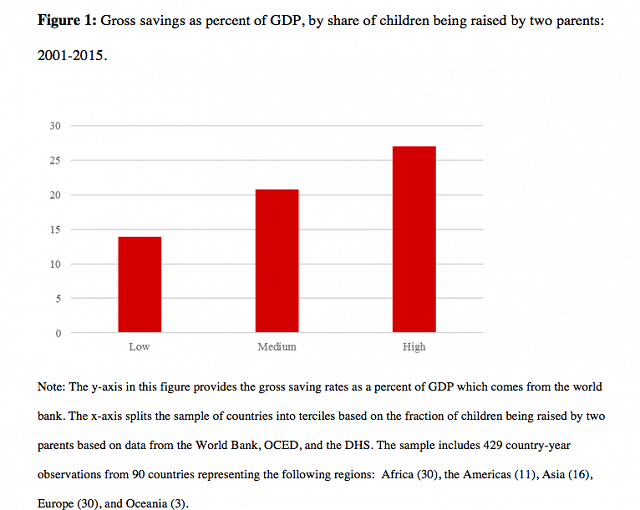Sociologist W. Bradford Wilcox and economist Joseph Price have an important chapter in a recent Cambridge-published book on the link between family structure and economic growth. They write,
A stable marriage matters in part because it allows couples to make decisions over time that maximize the economic prosperity of their family unit. Stably married persons have incentives to invest in their marriage and benefit from specialization and economies of scale; their households also tend to earn and save more than their peers who are unmarried or divorced (Stevenson and Wolfers 2007; Lerman and Wilcox 2014). Marriage also has a transformative effect on individuals, especially men. It seems to increase men’s productivity at and attachment toward work, and reduces men’s willingness to engage in risky behaviors, including criminal activity (Akerlof 1998; Nock 1998; Sampson, Laub, and Wimer 2006). What is more, it looks like married parenthood may be especially influential in encouraging men’s engagement in the labor force (Killewald 2012). In the aggregate, then, higher levels of marriage, and probably two-parent families, should boost men’s labor force participation and reduce criminal violence, both to the benefit of national economies. At the same time, insofar as motherhood tends to reduce women’s participation in the labor force (Budig and England 2001), we also explore the possibility that higher rates of marriage and two-parent families reduce growth. Finally, higher rates of intact marriage foster stable two-parent families, which are more likely than single parents to supply children with the human capital they need to thrive first in school and later in the labor force (Lerman and Wilcox 2014; McLanahan and Sandefur 1994). Accordingly, the more children are born and raised in stable, two-parent families, the more a society should experience economic growth (pg. 179-180).
Wilcox and Price continue to lay out the evidence that married, two-parents households:
- Have more income and savings.
- Lower crime rates.
- Higher educational achievements for children.


They conclude,
[W]e find that a significant association between family structure and
economic growth. Every 13 percentage point increase in the proportion of adults who are married is associated with an 8 percent increase in per capita GDP, net of controls for a range of sociodemographic factors. Likewise, every 13 percentage point increase in the proportion of children living in two-parent families is associated with a 16 percent increase in per capita GDP, controlling for education, urbanization, age, population size, and other factors. There is clearly a link between family structure and economic growth.…[W]e also note that the cross-national relationship between family structure, household savings, and crime are generally consistent with
our expectations about how marriage and two-parent families foster a social environment more conducive to economic growth in countries around the world. It is striking that more two-parent families are linked to less crime and more savings. If nothing else, the patterns documented in this paper suggest that stronger families, higher household savings rates, less crime, and higher economic growth may cluster together in mutually reinforcing ways....In conclusion, this chapter indicates that strong and stable families are
linked to higher levels of economic growth in nations across the globe, despite the fact that marriage and two-parent families are in decline across much of the globe. Given the potential economic importance of marriage and family stability to a nation’s economic life, policymakers, business leaders, and civic leaders should pursue a range of public and private policies to encourage and strengthen marriage and stable families. That is because what happens in the family may not affect only the welfare of private families but also the wealth of nations (pg. 194-195).
Economic institutions at the macro-level matter. But so do the ones at the micro-level. Probably more so.